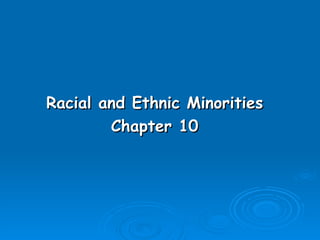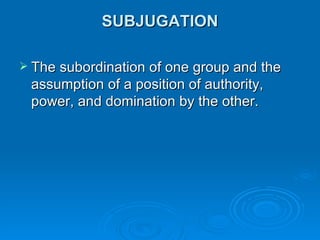- 1. Racial and Ethnic Minorities
Chapter 10
- 2. HISTORIC CONCEPT OF RACE
Race
A category of people who are defined as
similar because of a number of physical
characteristics.
- 3. HISTORIC CONCEPT OF RACE
Throughout history, races have been
defined along
Genetic Lines - No association
Legal Lines - Power based
Social Lines - Group membership
Can you identify any problems associated
with these means of definition?
- 4. SOCIAL DEFINITION
If a person presents themselves as a
member of a certain race and others
respond to that person as a member of
that race, then it makes little sense to say
that they are not a member of that race.
- 5. SOCIAL DEFINITION
The social definition of race is the decisive
one in most social interactions. It pays
little attention to an individual’s hereditary
physical features.
No different than ethnic self definition
of people with a similar culture
- 6. TERMS USING RACE
Multiracial Ancestry
Children who are born to parents of multiple races-
representing more than one race. Ancestors comes from
more than one race
Example - White/Asian
Interracial Marriage
Marriage between two people of differing racial groups.
Example - Black/White
•
- 7. ETHNIC GROUPS
Ethnic group
DEF: Has a distinct cultural tradition that its
own members identify with and that may or may
not be recognized by others.
Its members may be scattered throughout
existing countries or live in a narrow
geographical area.
Most of them form sub-cultures in a society
- 8. ETHNIC GROUPS
May or may not have their own separate
political unit (state, political party, etc)
They may have had one in the past or
aspire to have one in the future
They usually have high internal loyalty and
often possess distinctive folkways
- 9. THE CONCEPT OF MINORITY
Not defined as a small group in Sociology
DEF: A group of people who, because of
physical or cultural characteristics, are singled
out from others in society for differential and
unequal treatment, and who therefore regard
themselves as objects of discrimination.
- RACE, ETHNICITY, RELIGION, AGE,
GENDER,
- 10. PREJUDICE
Prejudice means a “prejudgment” or
“an attitude with an emotional
component
DEF: prejudice as an irrationally based
negative attitude toward certain groups
and their members
(Prejudice can be positive also).
- 11. FUNCTIONS OF PREJUDICE
First, a prejudice, because it is shared, helps
draw together those who hold it.
Second, when two or more groups are
competing prejudice can make it easier on the
conscience if one can write off competitors as
somehow less than human or inherently
unworthy.
Third, psychologists suggest that prejudice
allows us to project onto others parts of
ourselves that we do not like, creating a feeling
of superiority
- 12. DYSFUNCTIONS OF PREJUDICE
It does not provide a true picture of the social
world.
It can lead to discrimination, but does not always
do so.
It can prevent society, for optimizing potential
human resources
- 13. DISCRIMINATION
Prejudice is a subjective feeling, discrimination
is an overt action.
DEF: Discrimination refers to differential
treatment, usually unequal and injurious,
accorded to individuals who are assumed to
belong to a particular category or group.
- 14. MERTON’S TYPOLOGY
Unprejudiced Nondiscriminators
People are neither prejudiced against the
members of other racial and ethnic groups, nor
do they practice discrimination.
Unprejudiced Discriminators
Are not themselves prejudiced, but will tolerate
discrimantion. Includes those who constantly
think of expediency.
- 15. MERTON’S TYPOLOGY
Prejudiced Nondiscriminators
People who hold negative views of other groups
and who do not accept the ideal of equality for
all, but conform to it and give it lip service when
the slightest pressure is applied.
Prejudiced Discriminators
The bigots, pure and unashamed. Individual’s
who are prejudiced and voice and/or practice
discrimination
- 16. Institutional Prejudice and Discrimination
Refer to social arrangements that restrict the life
chances and choices of a specifically defined
group in comparison with those of the dominant
group.
- 17. Patterns of Racial and Ethnic
Relations
There are a limited number of possible
outcomes when different groups come
together
Assimilation
Is the process whereby groups with
different cultures come to have a common
culture.
Refers to the fusion of cultural heritages.
- 18. ASSIMILATION
Integration of new elements with old ones. It is
usually tilted towards the group with more power
The transferring of culture from one group to
another is a highly complex process, often
involving the rejection of old ideologies, habits,
customs, attitudes, and language.
Anglo conformity refers to The renunciation of the
ancestral cultures in favor of Anglo-American
behavior and values
- 19. PLURALISM
The development and coexistence of separate
racial and ethnic group identities within a society
Is a philosophical viewpoint that attempts to
produce what is considered to be a desirable
social situation.
- 20. PLURALISM
Theory
Celebrates the differences among groups of
people.
Provided a means for minorities to resist the pull
of assimilation by allowing them to claim that
they constitute the very structure of the social
order.
Assumes that the minority is a primary unit of
society and that the unity of the whole depends
on the harmony of the various parts.
- 21. SUBJUGATION
The subordination of one group and the
assumption of a position of authority,
power, and domination by the other.
- 22. SEGREGATION
Segregation, a form of subjugation, refers to the
act, process, or state of being set apart.
It places limits and restrictions on the contact,
communication, and social relations among
groups.
- 23. EXPULSION
The process of forcing a group to leave the
territory in which it lives.
Can be accomplished through forced
migration.
The relocation of a group through direct action
EX: AMERICAN INDIANS/TRAIL OF TEARS
- 24. ANNIHILATION
The deliberate extermination of a racial or ethnic
group.
EX: Nazi Germany killing of Jews and
Gypsys























